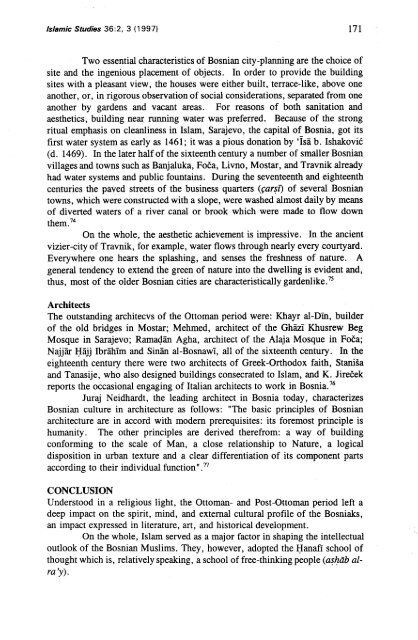Create successful ePaper yourself
Turn your PDF publications into a flip-book with our unique Google optimized e-Paper software.
Islamic Studies 3 6 : 2, 3 ( 1 9 9 7) 171<br />
Two essential characteristics of Bosnian city-planning are the choice of<br />
site and the ingenious placement of objects. In order to provide the building<br />
sites with a pleasant view, the houses were either built, terrace-like, above one<br />
another, or, in rigorous observation of social considerations, separated from one<br />
another by gardens and vacant areas. For reasons of both sanitation and<br />
aesthetics, building near running water was preferred. Because of the strong<br />
ritual emphasis on cleanliness in Islam, Sarajevo, the capital of Bosnia, got its<br />
first water system as early as 1461; it was a pious donation by 'is% b. IshakoviC<br />
(d. 1469). In the later half of the sixteenth century a number of smaller Bosnian<br />
villages and towns such as Banjaluka, FoEa, Livno, Mostar, and Travnik already<br />
had water systems and public fountains. During the seventeenth and eighteenth<br />
centuries the paved streets of the business quarters (car@) of several Bosnian<br />
towns, which were constructed with a slope, were washed almost daily by means<br />
of diverted waters of a river canal or brook which were made to flow down<br />
them.74<br />
On the whole, the aesthetic achievement is impressive. In the ancient<br />
vizier-city of Travnik, for example, water flows through nearly every courtyard.<br />
Everywhere one hears the splashing, and senses the freshness of nature. A<br />
general tendency to extend the green of nature into the dwelling is evident and,<br />
thus, most of the older Bosnian cities are characteristically gardenlike."<br />
Architects<br />
The outstanding architecvs of the Ottoman period were: Khayr al-Din, builder<br />
of the old bridges in Mostar; Mehmed, architect of the Ghai Khusrew Beg<br />
Mosque in Sarajevo; Ramadm Agha, architect of the Alaja Mosque in FoEa;<br />
NajjFr H2jj Ibr2him and Siniin al-Bosnawi, all of the sixteenth century. In the<br />
eighteenth century there were two architects of Greek-Orthodox faith, StaniSa<br />
and Tanasije, who also designed buildings consecrated to Islam, and K. JireEek<br />
reports the occasional engaging of Italian architects to work in Bosnia.76<br />
Juraj Neidhardt, the leading architect in Bosnia today, characterizes<br />
Bosnian culture in architecture as follows: "The basic principles of Bosnian<br />
architecture are in accord with modem prerequisites: its foremost principle is<br />
humanity. The other principles are derived therefrom: a way of building<br />
conforming to the scale of Man, a close relationship to Nature, a logical<br />
disposition in urban texture and a clear differentiation of its component parts<br />
according to their individual function" .n<br />
CONCLUSION<br />
Understood in a religious light, the Ottoman- and Post-Ottoman period left a<br />
deep impact on the spirit, mind, and external cultural profile of the Bosniaks,<br />
an impact expressed in literature, art, and historical development.<br />
On the whole, Islam served as a major factor in shaping the intellectual<br />
outlook of the Bosnian Muslims. They, however, adopted the Hanafi school of<br />
thought which is, relatively speaking, a school of free-thinking people (ashab al-<br />
ra 'y) .
















